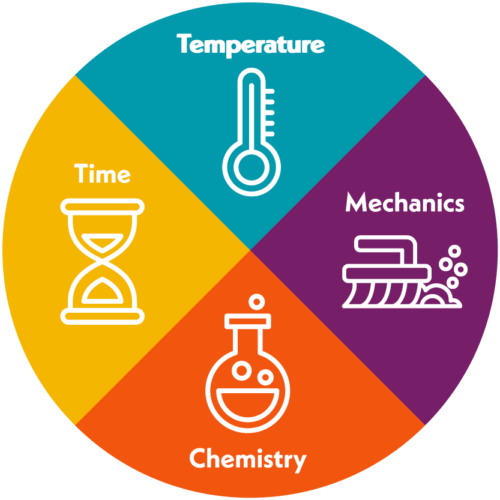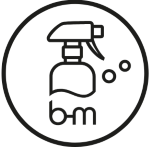Let’s talk Cleaning
BACK TO THE BASICS:
SINNER‘S CIRCLE
Back in 1959, a brilliant chemist named Herbert Sinner, who worked for Henkel, developed a simple model to explain all the different factors that affect cleaning. It’s called Sinner’s Circle, and it’s a total game-changer.
Sinner’s Circle illustrates the four key factors that work together to clean effectively (time, temperature, chemicals, and mechanics). And guess what? Each component can be adjusted as needed to achieve the perfect clean. With Sinner’s Circle, your cleaning game is about to go pro.


Chemistry = Which solution are you using
When it comes to cleaning, choosing the right chemicals is crucial. There are only so many ways to increase the other three factors involved in cleaning, which means that sometimes chemicals are the only way to get rid of dirt and grime.
Household cleaning is a science, with chemicals working their magic in various ways. Soaps and detergents for example use surfactants to trap oil and grease particles making them easy to wash off. If you’re dealing with stubborn mineral deposits in your bathroom, Citric Acid is your go-to solution as it reacts with these deposits, dissolving them from your surfaces. And when it comes to disinfecting bathroom surfaces during an illness or for deep cleaning, Oxygen Bleach is your superhero as it powerfully oxidizes germs. Where dirt is burnt onto a baking tray, scrubbing and soaking alone won’t do the trick; we need a suitable cleaning solution.
Don’t let the word ‘chemicals’ scare you off. Believe it or not, everything is technically a chemical, even our good ol’ friend H2O. And while some chemicals may be harmful, that doesn’t mean they all are. When it comes to Natural Cleaning, we steer clear of harsh and toxic chemicals and opt for safer, eco-friendly alternatives like Bicarbonate of Soda or Citric Acid. Learn more

Temperature = How warm is the solution
Temperature can have a big impact on how well your cleaning products work. When things heat up, the molecules in your cleaning solution start moving around faster, which helps dissolve stubborn dirt and grime more quickly. Whether you’re dealing with greasy, oily, or waxy messes, warm or hot water makes it easier to loosen them up. Plus, higher temperatures can help tackle other types of dirt more effectively, which means you may not need to rely on harsh chemicals or mechanical scrubbing as much.
The right temperature is a secret weapon when it comes to cleaning! Take washing dishes for instance – using hot water is the key to melting away that stubborn grease. And if you’re lucky enough to have a self-cleaning oven, you know firsthand how the intense heat can burn off all that caked-on food and grime.
However, there is a limit to how much heat can be thrown in the mix. Heat can not be increased infinitely. There’s a sweet spot – a perfect temperature where you’ll get maximum cleaning benefits without damaging the surface you’re cleaning. Beyond that ideal temperature, adding more heat is a waste of energy and could even do more harm than good. So let’s be smart and find that perfect temperature sweet spot. Learn more

Mechanics = What is the physical cleaning process
When we talk about “mechanical” cleaning, we’re referring to the physical elbow grease it takes to get rid of dirt. This involves a few different factors, like how much scrubbing power you’re applying (also known as abrasiveness), the amount of pressure you’re putting on the surface (contact pressure), and how often you’re moving your cleaning tools (frequency).
Mechanical cleaning techniques are all about using tools and machinery to get rid of the dirt and grime that accumulate in our homes. This can mean vacuuming carpets to suck up dust and debris, tossing clothes in the washing machine to freshen them up, dusting shelves to clear away specs of dust, wiping down counters with cloths to eliminate germs, and using brushes to scrub bathtub stains away.
If you want your cleaning game to be on point, it’s crucial to pick the right level of abrasion that suits the surface you’re working on. Trust us, you don’t want to end up with unwanted scratches on delicate areas just because you went for a steel sponge that’s too rough. On the other hand, using a gentle soft cloth might need more elbow grease but it’s the best way to ensure the results you’re looking for. And don’t worry, we’ve got a few tricks up our sleeves to help you out – just keep reading! Learn more

Time = How long do the other variables act
Let’s talk about the time factor when it comes to cleaning. This includes the contact time (how long the cleaning solution needs to do its thing) and the working time. Basically, the longer a surface is exposed to the cleaning solution, the better chance those powerful chemicals have to attack and get rid of dirt or grime. So, don’t rush the process – give it some time to work its magic!
Have you ever been stuck scrubbing a pot with stubborn, burnt-on food? So sit back, relax, and let time work for you: if you give it some time to soak, the dish detergent and water have a chance to do their job, loosening and dissolving the food so it’s easier to clean. This means less elbow grease for you and less detergent used, which is a win-win! The same goes for laundry. Give stained clothes a pre-soak in a stain remover before washing, and let the cleaner do the hard work of breaking down the dirt and oils.
Now, we know time is a luxury most of us don’t have and cleaning can be a daunting task. But don’t worry: we’ve got some nifty techniques to help you make the most of your cleaning time. Learn more
EFFECTIVE CLEANING
VARIABLES
How to use Sinners Circle for your Natural Cleaning Routine by adjusting variables:
In the realm of Sinners Circle, the variables work together like a tightly-knit team. Altering one of these factors means adjusting the others as well. It’s a delicate balance – increase one factor and the rest must decrease, decrease one and the others must rise to the occasion.
This concept of interdependence also plays a big role in the world of Natural Cleaning. Beware of cleaners claiming no-wipe or no-scrub capabilities – these shortcuts usually mean that stronger, harsher chemicals are at play.
By tweaking the four key factors of Sinners Circle (time, temperature, chemical, and mechanical), you can strike the perfect balance and make your cleaning routine both effective and eco-friendly.
Some ideas for adjusting Sinner‘s Circle for effective Natural Cleaning:

Try to soak oven racks in a Bicarbonate of Soda solution overnight instead of harsh oven cleaners (less chemical, more time).

Use a Melamine Sponge (Magic Sponge) to fight soapy grime instead of a no scrub bathroom cleaner (less chemical, more mechanical).

Pre-treat stains to effectively wash laundry in cold water (less thermal, more time).

Replace strong, hard water cleaners with a homemade Citric Acid spray and let it work for half an hour (less chemical, more time).

Replace harsh chemicals with Microfiber Cloths to effectively eliminate bacteria (less chemical, more mechanical).

Use Laundry Wool Balls in your drying cycle to soften clothes instead of dryer sheets (less chemical, more mechanical) and reduce drying time (more mechanical, less time).
